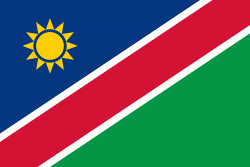Twyfelfontein
Twyfelfontein (Afrikaans: uncertain spring), officially known as ǀUi-ǁAis (Damara/Nama: jumping waterhole), is a site of ancient rock engravings in the Kunene Region of north-western Namibia. It consists of a spring in a valley flanked by the slopes of a sandstone table mountain that receives very little rainfall and has a wide range of diurnal temperatures.
The site has been inhabited for 6,000 years, first by hunter-gatherers and later by Khoikhoi herders. Both ethnic groups used it as a place of worship and a site to conduct shamanist rituals. In the process of these rituals at least 2,500 items of rock carvings have been created, as well as a few rock paintings. Displaying one of the largest concentrations of rock petroglyphs in Africa, UNESCO approved Twyfelfontein as Namibia's first World Heritage Site in 2007.
Twyfelfontein valley has been inhabited by Stone-age hunter-gatherers of the Wilton stone age culture group since approximately 6,000 years ago. They made most of the engravings and probably all the paintings. 2,000 to 2,500 years ago the Khoikhoi, an ethnic group related to the San (Bushmen), occupied the valley, then known under its Damara/Nama name ǀUi-ǁAis (jumping waterhole). The Khoikhoi also produced rock art which can clearly be distinguished from the older engravings.
The area was uninhabited by Europeans until after World War II, when a severe drought caused white Afrikaans speaking farmers (Boers) to move in. The farm was later procured by the apartheid government as part of the Odendaal Plan and became part of the Damaraland bantustan. The white settlers left in 1965.
Topographer Reinhard Maack, who also discovered the White Lady rock painting at Brandberg, reported the presence of rock engravings in the area in 1921. A more thorough investigation was only conducted after David Levin studied the feasibility of farming in 1947. He rediscovered the spring but struggled to extract enough water to sustain his family and his herd. Slowly becoming obsessed with doubts about the capacity of the spring an Afrikaans-speaking friend began calling him David Twyfelfontein (David Doubts-the-spring) in jest. When Levin bought the land and registered his farm in 1948 he gave it the name Twyfelfontein. While commonly being translated as doubtful spring, a more accurate translation for the word twyfel is therefore "questionable" or "uncertain".
In 1950 scientific investigation of the rock art started with an investigation by Ernst Rudolph Scherz who described over 2500 rock engravings on 212 sandstone slabs. it is estimated that the site contains more than 5000 individual depictions.
The site has been inhabited for 6,000 years, first by hunter-gatherers and later by Khoikhoi herders. Both ethnic groups used it as a place of worship and a site to conduct shamanist rituals. In the process of these rituals at least 2,500 items of rock carvings have been created, as well as a few rock paintings. Displaying one of the largest concentrations of rock petroglyphs in Africa, UNESCO approved Twyfelfontein as Namibia's first World Heritage Site in 2007.
Twyfelfontein valley has been inhabited by Stone-age hunter-gatherers of the Wilton stone age culture group since approximately 6,000 years ago. They made most of the engravings and probably all the paintings. 2,000 to 2,500 years ago the Khoikhoi, an ethnic group related to the San (Bushmen), occupied the valley, then known under its Damara/Nama name ǀUi-ǁAis (jumping waterhole). The Khoikhoi also produced rock art which can clearly be distinguished from the older engravings.
The area was uninhabited by Europeans until after World War II, when a severe drought caused white Afrikaans speaking farmers (Boers) to move in. The farm was later procured by the apartheid government as part of the Odendaal Plan and became part of the Damaraland bantustan. The white settlers left in 1965.
Topographer Reinhard Maack, who also discovered the White Lady rock painting at Brandberg, reported the presence of rock engravings in the area in 1921. A more thorough investigation was only conducted after David Levin studied the feasibility of farming in 1947. He rediscovered the spring but struggled to extract enough water to sustain his family and his herd. Slowly becoming obsessed with doubts about the capacity of the spring an Afrikaans-speaking friend began calling him David Twyfelfontein (David Doubts-the-spring) in jest. When Levin bought the land and registered his farm in 1948 he gave it the name Twyfelfontein. While commonly being translated as doubtful spring, a more accurate translation for the word twyfel is therefore "questionable" or "uncertain".
In 1950 scientific investigation of the rock art started with an investigation by Ernst Rudolph Scherz who described over 2500 rock engravings on 212 sandstone slabs. it is estimated that the site contains more than 5000 individual depictions.
Map - Twyfelfontein
Map
Country - Namibia
 |
 |
| Flag of Namibia | |
The driest country in sub-Saharan Africa, Namibia has been inhabited since pre-historic times by the San, Damara and Nama people. Around the 14th century, immigrating Bantu peoples arrived as part of the Bantu expansion. Since then, the Bantu groups, the largest being the Ovambo, have dominated the population of the country; since the late 19th century, they have constituted a majority. Today Namibia is one of the least densely populated countries in the world.
Currency / Language
| ISO | Currency | Symbol | Significant figures |
|---|---|---|---|
| NAD | Namibian dollar | $ | 2 |
| ZAR | South African rand | Rs | 2 |
| ISO | Language |
|---|---|
| AF | Afrikaans language |
| EN | English language |
| DE | German language |
| HZ | Herero language |















